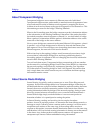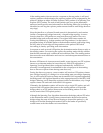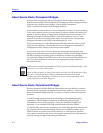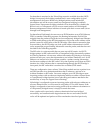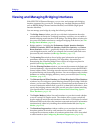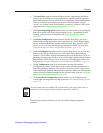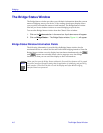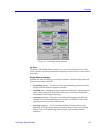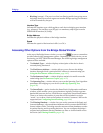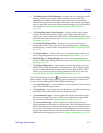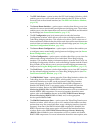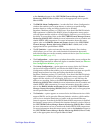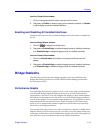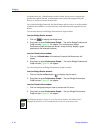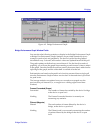
Bridging
4-10 The Bridge Status Window
¥ Blocking (orange)ÑThe port is on-line, but Þltering trafÞc from going across
the bridge from one network segment to another. Bridge topology information
will be forwarded by the port.
Interface Type
Indicates the interface type which applies to each device bridging port interface
(e.g., ethernet). The interface type (ifType) is a mandatory object type from the
SNMP MIB II Interface (if) Group.
Bridge Address
Indicates the physical address of the bridge interface.
Speed
Indicates the speed of the interface in Mb/s or Gb/s.
Accessing Other Options from the Bridge Status Window
At the top of the Bridge Status window, you can click to access a menu that
provides other bridge management options. Depending on which device you are
monitoring via SPECTRUM Element Manager, the following bridge management
options will be available:
¥ The Module TypeÉ window displays a description of the device that is
currently being monitored.
¥ The Find Source AddressÉ window allows you to discover the bridge
interface through which a particular MAC address is communicating (see
Using the Find Source Address Feature, page 4-63).
¥ The Performance GraphÉ window displays statistics for trafÞc across the
entire bridge (see Performance Graphs, page 4-15).
¥ The Spanning TreeÉ window allows you to set the Spanning Tree Algorithm
parameters for bridging on your device (see Bridge Spanning Tree,
page 4-35).
¥ The SmartTrunkÉ option invokes the SmartTrunk ConÞguration and Status
window, which enables you to group interfaces logically to achieve greater
bandwidth between devices, if both devices support the SmartTrunk feature.
There is no limit to the number of ports that can be included in a single
Òtrunk,Ó nor is there a limit to the number of trunked ÒinstancesÓ that can be
supported (see ConÞguring SmartTrunking, page 4-96).
¥ The Filtering DatabaseÉ window lets you see the contents of the Static and
Learned databasesÑthe two address databases which construct the IEEE 802.1
Source Address Table. The bridge uses the contents of these databases to make
its packet Þltering and forwarding decisions. You can conÞgure the bridgeÕs
acquired and permanent Þltering databases to Þlter or forward trafÞc across
the device (see Filtering Database, page 4-42).



